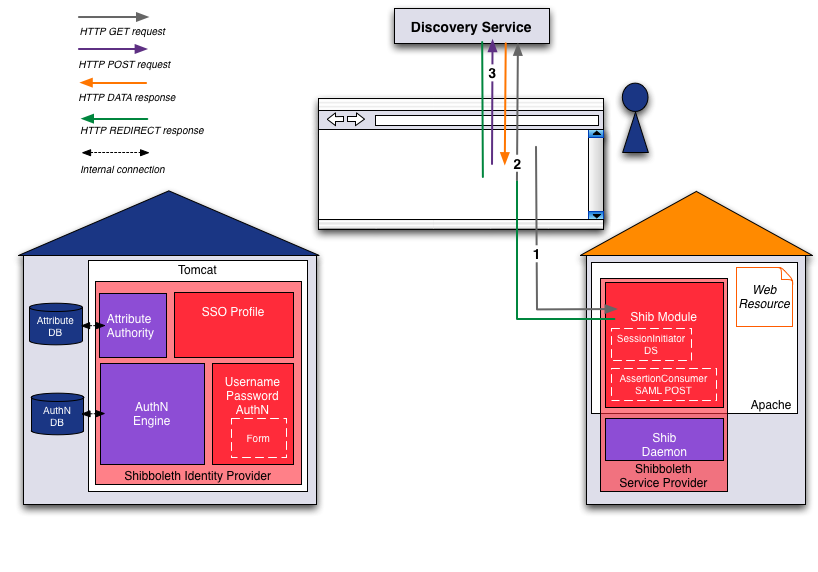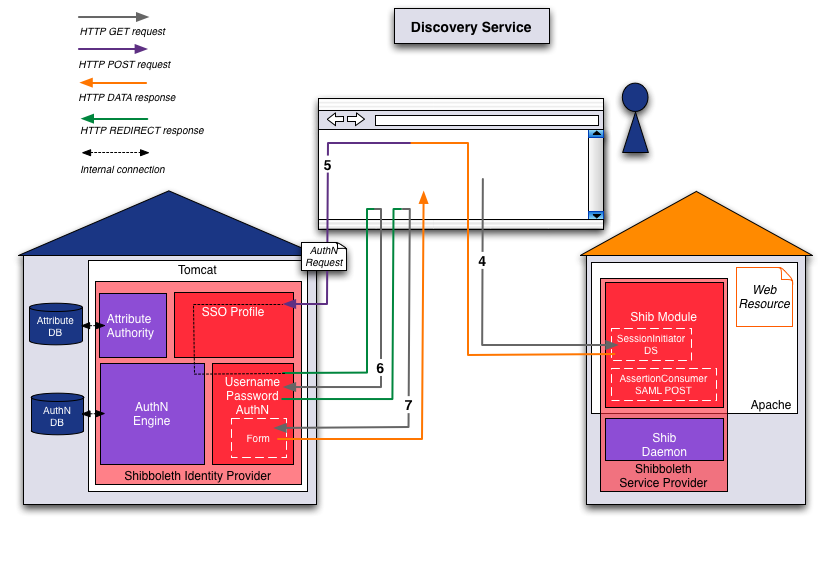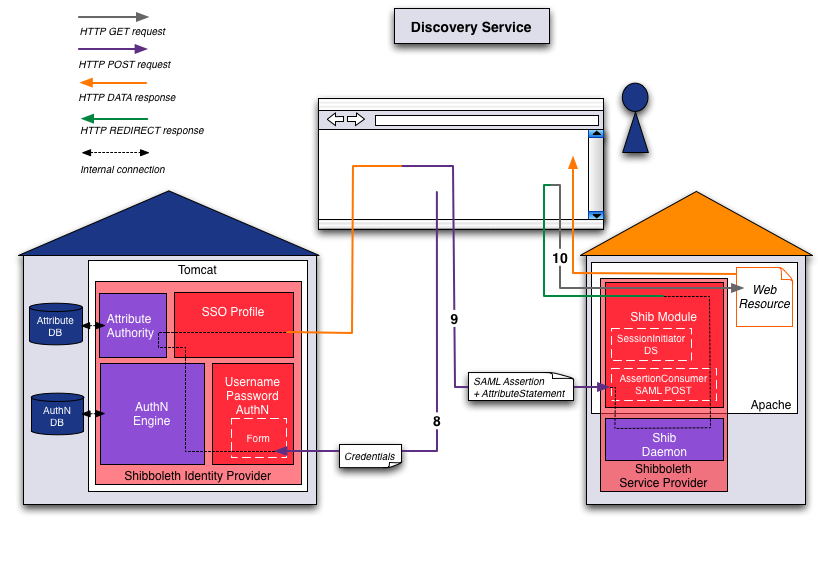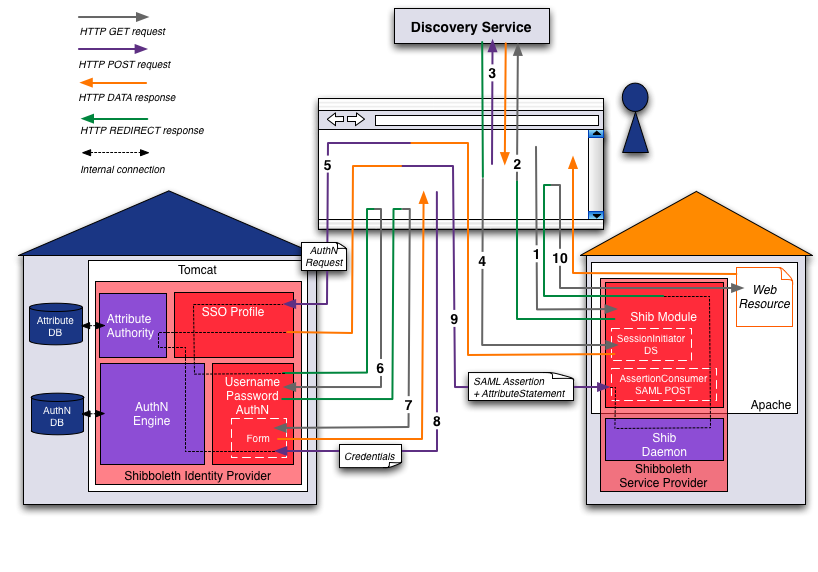Expert Demo
|
To be better able to understand this technical introduction, we strongly recommend you to read
the simple demo and the medium demo first. The content of this introduction is aimed at technicians and therefore quite detailed. |
Overview
As shown in Fig. 1 the scenario is the same as in the simple demo and the medium demo but background processes and interacting components are also considered in this introduction.
In the following, it is distinguished between the data sent from the user's web browser to the web server
(GET requests and POST requests)
and the data received by the user from the web server
(redirect responses and data responses).
Some detail information is emphasized using a [DETAIL POPUP] link.
For better readability the data is shown in URL decoded form, e.g. a '://' would be '%3A%2F%2F' in the real data.
Phase 1 - First access to the Service Provider and Identity Provider discovery
- Step 1 (User ⇔ Browser ⇔ Service Provider):
- The user opens a web browser and accesses the Service Provider located at https://aai-demo.switch.ch/secure.
His web browser sends the following request:
GET https://aai-demo.switch.ch/secure
Because https://aai-demo.switch.ch/secure is protected by the Shibboleth Service Provider, it is checked if the user already has a Shibboleth session and therefore was authenticated already. If the user is not authenticated, the web server answers with an HTTP Redirect to the Discovery Service located at wayf-test.switch.ch. Since the Discovery Service server needs to know where to return the user's Home Organization selection to, the relevant information is provided as GET parameter:302 FOUND (REDIRECT) Set-Cookie: _shibstate_64656661756c7468747470733a2f2... value=https://aai-demo.switch.ch/secure path=/ Location: https://wayf-test.switch.ch/SWITCHaai/WAYF ?entityID=https://aai-demo.switch.ch/shibboleth &return=https://aai-demo.switch.ch/Shibboleth.sso/Login?SAMLDS=1&target=ss:mem - Step 2: (Browser ⇔ Discovery Service)
-
Consequently, the web browser sends a new request to the Discovery Service:
GET https://wayf-test.switch.ch/SWITCHaai/WAYF ?entityID=https://aai-demo.switch.ch/shibboleth &return=https://aai-demo.switch.ch/Shibboleth.sso/Login?SAMLDS=1&target=ss:memThe Discovery Service answers with the web page that allows the user to select an Identity Provider:200 OK [WAYF DROPDOWN HTML PAGE]
- Step 3: (User ⇔ Browser ⇔ Discovery Service)
-
On the Discovery Service page, the user submits the Identity Provider selection:
POST https://wayf-test.switch.ch/aaitest/WAYF?entityID=https://aai-demo.switch.ch/shibboleth&return=https://aai-demo.switch.ch/Shibboleth.sso/Login?SAMLDS=1&target=ss:mem POSTDATA user_idp=https://aai-demo-idp.switch.ch/idp/shibbolethThe Discovery Service sends a redirect to the return destination including the IdP selection:302 FOUND (REDIRECT) Location: https://aai-demo.switch.ch/Shibboleth.sso/Login ?SAMLDS=1 &target=ss:mem &entityID=https://aai-demo-idp.switch.ch/idp/shibboleth
Phase 2 - Session initiation and authentication request
- Step 4 (Browser ⇔ Service Provider):
-
Due to the previous redirect response, the browser sends the following request:
GET https://aai-demo.switch.ch/Shibboleth.sso/Login ?SAMLDS=1 &target=ss:mem &entityID=https://aai-demo-idp.switch.ch/idp/shibbolethThe session initiator creates an authentication request and returns it within an auto-submit-post-form:200 OK [AUTHN REQUEST POST FORM HTML PAGE]
- Step 5 (Browser ⇔ Identity Provider):
-
The browser posts the following request with use of Javascript automatically:
POST https://aai-demo-idp.switch.ch/idp/profile/SAML2/POST/SSO POSTDATA RelayState=ss:mem:23e3a3b1268acd89dc226bb1ce0d0c6ba7ecf773 SAMLRequest=PHNhbWxwOkF1dGhuUmVxdWVzdCB4bWxuczp...The Identity Provider checks the authentication request, because the user is not authenticated, it sends a redirect to the appropiate login handler (here: Username/Password):302 MOVED TEMPORARILY (REDIRECT) Set-Cookie: _idp_authn_lc_key value=C22C16A197CB9606067A1A577EF5D996 Path=/idp Secure Location: https://aai-demo-idp.switch.ch:443/idp/AuthnEngine - Step 6 (Browser ⇔ Identity Provider):
-
The web browser is redirected to the username/password login handler:
GET https://aai-demo-idp.switch.ch/idp/AuthnEngine Cookie: _idp_authn_lc_key value=C22C16A197CB9606067A1A577EF5D996The Identity Provider redirects then to the specific username/password web page:302 MOVED TEMPORARILY (REDIRECT) Location: https://aai-demo-idp.switch.ch:443/idp/Authn/UserPassword
- Step 7 (Browser ⇔ Identity Provider):
-
The browser sends subsequently a GET request for the username/password web page:
GET https://aai-demo-idp.switch.ch/idp/Authn/UserPassword Cookie: _idp_authn_lc_key value=C22C16A197CB9606067A1A577EF5D996The web server responds with the username/password page:200 OK [USERNAME PASSWORD LOGIN FORM HTML PAGE]
- Step 8 (User ⇔ Browser ⇔ Identity Provider):
-
The user types his username and password credentials and submits them to the Identity Provider:
POST https://aai-demo-idp.switch.ch/idp/Authn/UserPassword POSTDATA j_username=demouser j_password=demo Cookie: _idp_authn_lc_key value=C22C16A197CB9606067A1A577EF5D996The Identity Provider's authentication engine verifies the credentials. After the user/principal was sucessfully authenticated, the attribute authority will perform the attribute resolving and attribute filtering. Then an HTML page is generated which includes a SAML assertion. Because this assertion contains not only an authentication statement but also an attribute statement with the user's attributes, this way of sending the attributes is called "Attribute Push". The assertion is transmitted using an auto-submit-post-form:200 OK Set-Cookie: _idp_session value=4m2ETlKYtvbNEmBzVNo3UHLuKSdo3HqTUqAmeZiar94= Path=/idp [ASSERTION POST FORM HTML PAGE] - Step 9 (Browser ⇔ Service Provider):
-
The web browser posts the following request immediately:
POST https://aai-demo.switch.ch/Shibboleth.sso/SAML2/POST POSTDATA RelayState=cookie SAMLResponse=PD94bWwgdmVyc2lvbj0iMS4wIiBlbmNvZGl... Cookie: _shibstate_64656661756c7468747470733a2f2... value=https%3A%2F%2Faai-demo.switch.ch%2FsecureThe Service Provider processes the SAML assertion including the authentication and attribute statements. Finally it sends a redirect to the prior requested ressource, whose URL was stored in the _shibstate cookie:302 FOUND (REDIRECT) Set-Cookie: _shibstate_64656661756c7468747470733a2f2... value= path=/ Set-Cookie: _shibsession_64656661756c7468747470733a2f2... value=_0b6d4e89d2e9c4481738094f2a2c9de0 path=/ Location: https://aai-demo.switch.ch/secure - Step 10 (Browser ⇔ Service Provider):
-
As in step 1, the browser requests again the protected resource at https://aai-demo.switch.ch/secure:
GET https://aai-demo.switch.ch/secure Cookie: _shibsession_64656661756c7468747470733a2f2... value=_0b6d4e89d2e9c4481738094f2a2c9de0This time however, the user is authenticated. To decide whether a user is allowed to access a protected resource, the mod_shib module embedded in the Apache web server examines the Shibboleth access rules and tries to match them using the user's attributes. In this demo, the following access rules is used (any authenticated user is able to access):# content of secure/.htaccess AuthType shibboleth ShibRequireSession On require valid-user
The Service Provider returns the content of accessed page:200 OK [RESOURCE HTML PAGE]
Phase 3 - Authentication, attribute statement and access
Summary - Shibboleth Login Procedure
Subsequent accesses to the Service Provider are granted directly until the Shibboleth session timeout requires a fresh authentication.
Expert Session Add-On
| Take a look at the expert session add-on if you would like to see the flows when SP or IdP session is already existent. |
Medium Demo
| Take a look at the medium demo if you would like to see this login procedure in action. |




